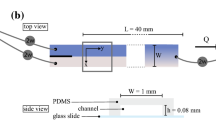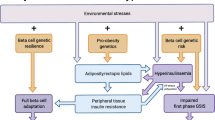Abstract
Purpose. Endothelium insulin permeability was investigated using in vitro, dynamic culture of endothelial cells.
Methods. Endothelial cells were cultured in a hollow fiber apparatus and continuously exposed to a flow. Transendothelial electrical resistance and permeability to [14C]sucrose and [14C]inulin were used to monitor the integrity of the endothelial monolayer.
Results. Under these experimental conditions, measurements of insulin permeability, investigated at increasing hormone concentrations, suggested that the predominant transendothelial insulin fluxes were attributable to bidirectional convective transport rather than to a saturable transport mechanism, in agreement with in vivo experiment results published earlier. Analytical determinations of insulin catabolism demonstrated a low percent of insulin degradation by the endothelium, leading to production of insulin metabolites qualitatively identical to those produced by human monocytes.
Conclusions. The findings of this paper indicated that (a) insulin crosses the endothelial monolayer by paracellular “leak” and endothelial insulin receptors have a minor (if any) role in insulin transport; (b) degradation of the hormone by BAEC is minimal; (c) the in vitro, dynamic culture of endothelial cells presented here should represent a valuable transport model system to study permeability mechanisms of insulin and many other drugs.
Similar content being viewed by others
REFERENCES
E. M. Landis, J. R. Pappenheimer. Exchange of substances through capillary walls. In Handbook of Physiology, Circulation. Section 2, Vol. 2. Am. Physiol. Soc. (eds.) W. F. Hamilton cd., Washington, D.C., 1963 pp. 961–1034.
M. Bundgaard. Vescicular transport in capillary endothelium: does it occur? Fed. Proc. 42:2425–2430 (1983).
L. Ghitescu, A. Fixman, M. Simionescu, and N. Simionescu. Specific binding sites for albumin restricted to the plasmalemmal vescicles of continuous capillary endothelium: receptor mediated transcytosis. J. Cell. Biol. 102:1304–1311 (1986).
G. L. King and S. M. Johnson. Receptor-mediated transport of insulin across endothelial cells. Science 227:1583–1585 (1985).
R. S. Bar, M. Boes, and A. Sandra. Vascular transport of insulin to rat cardiac muscles. Central role of the capillary endothelium. J. Clin. Invest. 81:1225–1233 (1988).
P. E. Jansson, J. P. Fowelin, H. P. von Schenck, and U. P. Smith. and P N. Lonnroth. Measurements by microdialysis of the insulin concentration in subcutaneous interstitial fluid. Diabetes 42:1469–1473 (1993).
R. S. Bar, J. C. Hoak, and M. L. Peacock. Insulin receptors in human endothelial cells identification and characterization. J. Clin. Endocrinol. Metab. 47:699–702 (1978).
S. G. Milton and V. P. Knutson. Comparison of the function of the tight junctions of endothelial cells and epithelial cells in regulating the movement of electrolytes and macromolecules across the cell monolayer. J. Cell. Physiol. 144:498–504 (1990).
G. M. Steil, M. Ader, D. M. Moore, K. Rebrin, and R. N. Bergman. Transendothelial insulin transport is not saturable in vivo. No evidence for a receptor-mediated process. J. Clin. Invest. 97:1497–1503 (1996).
F. Brunner and T. C. Washer. Contribution of the endothelium to transcapillary insulin transport in rat isolated perfused hearts. Diabetes 47:1127–1134 (1998).
P. F. Davies, K. A. Volin, and M. V. Robotewskyi. Spatial relationship in early signaling events of flow-mediated endothelial mechanotransduction. Ann. Rev. Physiol. 59:527–549 (1997).
G. A. Grant, N. J. Abbott, and D. Janigro. Understanding the physiology of the blood-brain barrier: in vitro models. News Physiol. Sci. 13:287–293 (1998).
R. A. Knazek, P. M. Gullino, P. O. Kohler, and R. L. Dedrik. Cell culture on artificial capillaries: an approach to tissue growth in vitro. Science 178:65–67 (1972).
M. J. Ott, J. L. Olson, and B. J. Ballermann. Chronic in vitro flow promotes ultrastructural differentiation of endothelial cells. Endothelium 3:21–30 (1995).
K. A. Stanness, L. E. Westrum, E. Fornaciari, P. Mascagni, J. A. Nelson, S. G. Stenglein, T. Myers, and D. Janigro. Morphologic and functional characterization of an in vitro blood-brain model. Brain Res. 771:329–342 (1997).
L. Benzi, A. M. Ciccarone, P. Cecchetti, G. DiCianni, F. Caricato, L. Trincavelli, L. Volpe, and R. Navalesi. Intracellular hyperinsulinism: a metabolic characteristic of obesity with and without type 2 diabetes. Diabetes Res. Clin. Pract. 46:231–237 (1999).
L. Benzi, P. Cecchetti, A. M. Ciccarone, and A. Pilo. Insulin degradation in vitro and in vivo: a comparative study in men. Diabetes 43:297–304 (1994).
K. D. Dernovsek and R. S. Bar. Processing of cell-bound insulin by capillary and macrovascular endothelial cells in culture. Am. J. Physiol. 33:E244–E251 (1985).
I. Jalal, G. L. King, S. Buchwald, C. R. Kahn, and M. Crettaz. Processing of insulin by bovine endothelial cells in culture. Diabetes 33:794–800 (1984).
L. Benzi, P. Cecchetti, A. M. Ciccarone, and A. Nardone. Inhibition of endosomal acidification in normal cells mimics the derangements of cellular insulin and insulin-receptor metabolism observed in non-insulin-dependent diabetes mellitus. Metabolism 46:1259–1265 (1997).
V. Trischitta, D. Gullo, S. Squatrito, V. Pezzino, I. D. Goldfine, and R. Vigneri. Insulin internalization into monocytes is decreased in patients with type II diabetes mellitus. J. Clin. Endocrinol. Metab. 62:522–528 (1986).
P. W. Kazakoff, T. R. McGuire, E. B. Hoie, M. Cano, and P. L. Iversen. An in vitro model for endothelial permeability: assessment of monolayer integrity. In Vitro Cell Dev. Biol. 31:846–852 (1995).
P. G. Bannon, K. Mi-Jurng, R. T. Dean, and J. Dawes. Augmentation of vascular endothelial barrier function by heparin and low molecular weight heparin. Thromb. Haemost. 73:706–712 (1995).
J. A. Oliver. Endothelium-derived relaxing factor contributes to the regulation of endothelial permeability. J. Cell Physiol. 151:506–511 (1992).
W. C. Duckworth. Insulin degradation: mechanisms, products, and significance. Endocr. Rev. 9:319–345 (1988).
C. W. Patrick, Jr. and L. V. McIntire. Bioengineering contributions in vascular biology at the cellular and molecular level. Trends Cardiovasc. Med. 6:122–129 (1996).
G. Kilic, R. B. Doctor, and J. G. Fitz. Insulin stimulates membrane conductance in a liver cell line. J. Biol. Chem. 276:26762–26768 (2001).
W. P. Paaske and P. Sejersen. Transcapillary exchange of 14Cinulin by free diffusion in channel of fused vesicles. Acta Physiol. Scan. 100:437–455 (1977).
C. Crone. The permeability of capillaries in various organs as determined by use of the 'indicator diffusion' method. Acta Physiol. Scan. 58:292–305 (1963).
K. Shii, S. Baba, K. Yokono, and R. A. Roth. Covalent linkage of 124I-insulin to a cytosolic insulin degrading enzyme. J. Biol. Chem. 260:6503–6506 (1985).
Author information
Authors and Affiliations
Corresponding author
Rights and permissions
About this article
Cite this article
Salvetti, F., Cecchetti, P., Janigro, D. et al. Insulin Permeability Across an in Vitro Dynamic Model of Endothelium. Pharm Res 19, 445–450 (2002). https://doi.org/10.1023/A:1015187410909
Issue Date:
DOI: https://doi.org/10.1023/A:1015187410909




